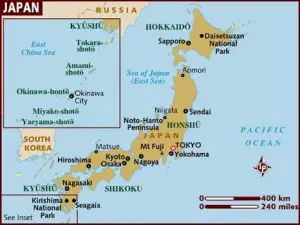 The Japanese Archipelago lies in the eastern part of the Asian continent, stretching from the Tropics in the south to the Subpolar zone in the north. This archipelago is formed of over 4.000 islands. A bird’s eye view over the region area’s map distinguishes four large islands and a boom of other smaller islands grouped together or spread out in the vastness of the Pacific Ocean. Five hundred of these islands are currently inhabited.
The Japanese Archipelago lies in the eastern part of the Asian continent, stretching from the Tropics in the south to the Subpolar zone in the north. This archipelago is formed of over 4.000 islands. A bird’s eye view over the region area’s map distinguishes four large islands and a boom of other smaller islands grouped together or spread out in the vastness of the Pacific Ocean. Five hundred of these islands are currently inhabited.
The four large islands, from north to south, are: Hokkaido, Honshu, Shikoku and Kyushu. Honshu, named after its political-administrative ancient name of Honcho, stretches on the widest area and is the most important island. The biggest Japanese cities such as, Tokyo, Yokohama, Osaka, Kobe, and Kyoto are located here.
The Inland Sea, a body of water almost closed between the Japanese islands, is an important part of the Japanese territory. Japan’s relief is characterised by two major landorms: mountains and waterways. Throughout the history of Japan, these two inseparable elements had been combined in the most varied and spectacular ways in many art forms. Fuji, the highest mountain, soaring at 3.776 m above sea level, is today an inactive volcano. For some, it is the most beloved mountain in the world.
The Japanese medieval administrative system divided the coutnry into 84 provinces (kuni). This system was abandoned during the Modern era and an administrative division of 43 prefectures (ken) was set up instead. To this, a metropolitan district (to) was added, and then three other metropolitan regions (do and fu), thus raising the total to 47 local divisions. The four metropolitan regions are Tokyo, Osaka, Nagoya and Kita-kyushu. There also exists a division into eight geographical regions: Hokkaido, Tohoku, Kanto, Chubu, Kinki, Chugoku, Shikoku and Kyushu.
An earlier version of this text was published in
The Spirit of Medieval Japan (Nipponica Publishing House, 1999)
Photo source: Lonely Planet

